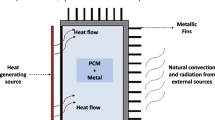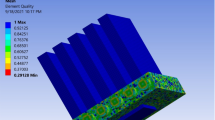Abstract
Electronic systems are anticipated to give superior Quality-of-Service parameters such as fast speed, thin size, and high efficiency for future generation systems. The main issue in producing high functionality systems is heat dissipation at the working units. This is due to the fact that the operating temperature of electronic systems for commercial applications is limited to 70 °C, beyond which the electronic circuits may malfunction and cause the entire system to fail. As a result, heat optimization of electronic circuits is a critical solution for meeting the increased functionality and denser circuits for on-chip systems in any thin sized end products. In this work, the experimental unit is modeled to examine the forced convective modes of fluid and heat transfer characteristics are demonstrated. It has been discovered that turbulent fluid flow when propagated in multichannel has a superior heat transfer effect and optimizes the latent heat created at the circuit.










Similar content being viewed by others
References
Ramesh Bapu, B. R., Kayalvizhi, S., & Murugavalli, S. (2020). Two phase cooling with nano-fluid for highly dense systems. Microelectronics Reliability, 103(C), 113640.
Prasad, J. S., Muthukumar, P., Anandalakshmi, R., & Niyas, H. (2018). Comparative study of phase change phenomenon in high temperature cascade latent heat energy storage system using conduction and conduction-convection models. Solar Energy, 176, 627–637.
Alenezi, A. H., Almutairi, A., Alhajeri, H. M., Addali, A., & Gamil, A. A. (2018). Flow structure and heat transfer of jet impingement on a rib-roughened flat plate. IEEE Transactions on Components, Packaging, and Manufacturing Technology, 12, 2122–2129.
Dash, R., Majumdar, A., Pangracious, V., Turuk, A. K., & Risco-Martin, J. L. (2018). ATAR: An adaptive thermal-aware routing algorithm for 3-D network-on-chip systems. IEEE Transactions on Components, Packaging, and Technology, 12, 2122–2129.
Kaood, A., Abou-Deif, T., Eltahan, H., Yehia, M. A., & Khalil, E. E. (2018). Numerical investigation of heat transfer and friction characteristics for turbulent flow in various corrugated tubes. Journal of Power and Energy, 233(4), 457–475.
Guo, H.-J., Ye, W.-B., Huang, S.-M., Wu, S.-Y., & Peng, D.-Q. (2018). Laminar flow and heat transfer characteristics of microchannel heat sinks combined with ribs and cavities for electronic cooling. Computational Thermal Sciences, 10, 103–119.
Liang, G., & Mudawar, I. (2019). Review of single-phase and two-phase nanofluid heat transfer in macro-channels and micro-channels. International Journal of Heat and Mass Transfer, 136, 324–354.
Lu, S., & Vafai, K. (2016). A comparative analysis of innovative microchannel heat sinks for electronic cooling. International Journal of Heat and Mass Transfer, 76, 271–284.
Goodarzi, M., Amiri, A., Goodarzi, M. N., Safaei, M. R., Karimipour, A., Languri, E. M., & Dahari, M. B. (2015). Investigation of heat transfer and pressure drop of a counter flow corrugated plate heat exchanger using MWCNT based nanofluids. International Communications in Heat and Mass Transfer, 66, 172–179.
Sarafraz, M. M., Tlili, I., Tian, Z., Bakouri, M., Goodarzi, M., & Safaei, M. R. (2019). Thermal evaluation of graphene nanoplatelets nanofluid in a fast-responding HP with the potential use in solar systems in smart cities. Journal of Applied Sciences, 9, 1–11.
Goshayeshi, H. R., Goodarzi, M., Safaei, M. R., & Dahari, M. (2016). Experimental study on the effect of inclination angle on heat transfer enhancement of a ferrofluid in a closed loop oscillating heat pipe under magnetic field. Experimental Thermal and Fluid Science, 74, 265–270.
Gruener, W. (2008). IBM cools 3D chips with integrated water channels. Science Daily. www.sciencedaily.com/releases/2008/06/080606152512.htm.
Parida, P. R., Sridhar, A., Schultz, M., Yang, F., Gaynes, M., Colgan, E., Dang, B., McVicker, G., Brunschwiler, T., Knickerbocker, J., Chainer, T. (2017) Modeling embedded two-phase liquid cooled high power 3D compatible electronic devices. In Thermal measurement modeling and management symposium (SEMI-THERM) 2017 33rd (pp. 130–138).
Ariyo, D. O., & Bello-Ochende, T. (2020). Constructal design of subcooled microchannel heat exchangers. International Journal of Heat and Mass Transfer, 146, 118835–118844.
Author information
Authors and Affiliations
Corresponding author
Additional information
Publisher's Note
Springer Nature remains neutral with regard to jurisdictional claims in published maps and institutional affiliations.
Rights and permissions
About this article
Cite this article
Ramesh Bapu, B.R., Kayalvizhi, S. & Murugavalli, S. Numerical Analysis of Thermal Management of On-Chip Circuits. Wireless Pers Commun 121, 3029–3040 (2021). https://doi.org/10.1007/s11277-021-08862-w
Accepted:
Published:
Issue Date:
DOI: https://doi.org/10.1007/s11277-021-08862-w




